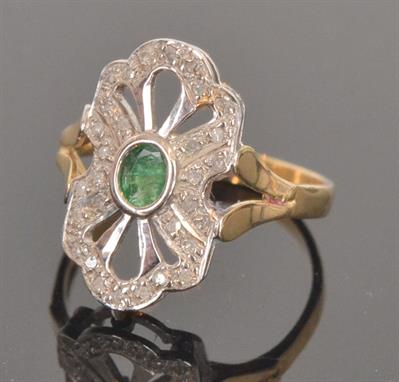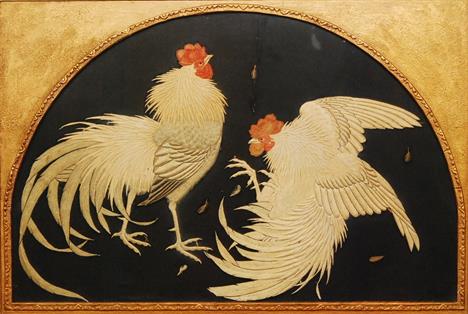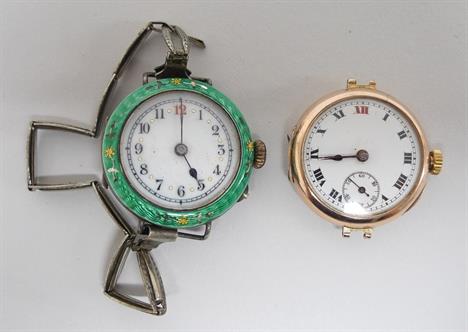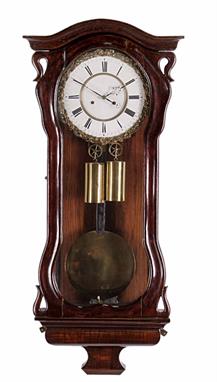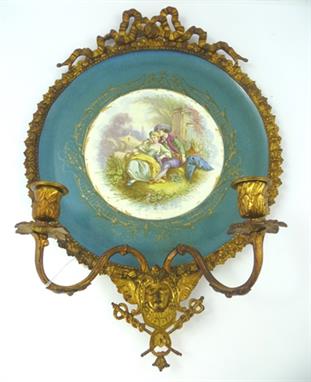x Uganda 1898-1902 Definitive Issue Essays Five stamp-size essays affixed to individual cards (90x114mm.), "a" for a small format 2a. and "b" for a large format 2r., both showing the Queen`s portrait in a double-oval surround and dated "Jan. 24th. 98.", rejected by E.E. Blake, Crown Agent General who wrote "The use of this portrait seems to spoil the stamps and render them feeble-looking and conventional.....I must ask you to try again", "c" for small format 2a and "d" for large format 2r. in the accepted designs and dated "Feb. 18th. 98.", a letter from De La Rue stating "...enclosed designs are modifications to the designs...originally submitted, carried out in accordance with the instructions given to us by Mr. Blake", all four photographic, and "e" for a small format 2a. design, composite with the frame photographic in brown and the vignette with an engraved portrait of an ostrich, dated "Febr. 18th. 98.", a note from De La Rue stating "...we ourselves think this design... C... would make by far handsomer stamps". A most attractive and unique group. Photo View Terms & Conditions
We found 79002 price guide item(s) matching your search
There are 79002 lots that match your search criteria. Subscribe now to get instant access to the full price guide service.
Click here to subscribe- List
- Grid
-
79002 item(s)/page
A sterling silver Norwegian and enamel brooch by Øystein Balle of Stavanger, with overlapping curves with guilloché green enamel, together with a modernist perspex brooch/pendant, with a clear perspex plaque with pink, green and black decoration to a flat surround. Brooch pin and a pair of pendant hooks. Probably American (2) CONDITION REPORT: 1. No losses to the enamel. Tarnish. Light gilding to the reverse with patchy tarnish. 2. Light surface wear with shaded tarnish to the frame and reverse.
David Shepherd O.B.E. Evening in the Kaokoveld ( signed & numbered) 680 x 340mm Evening in the Kaokoveld, Fine Art Print, signed by the artist ,numbered, with mount board, image is 680 x 340mm (excluding surround), condition:very good. The image portrays the Desert Elephant at Naweb Mountain ( the Mountain that beckons). David Shepherd has ties with Africa over many decades. very good David Shepherd Click here to view further details and images and to bid
BINDING: MELVILLE (LEWIS) - The Windsor Beauties, n.d. circa 1928, Hutchinson & Co., silk doublures, gilt tooled dentelles, red morocco richly gilt and jewelled, by Bayntun Bath, the upper cover with a hand painted portrait miniature of Barbara Villiers behind glass within a green morocco jewel inset surround, a.e.g. in a red slip box. See illustration
A French Empire gilt and patinated bronze figural mantel timepiece Now with rack lever watch movement by Litherland and Company, Liverpool, early 19th century The four pillar fusee full-plate movement with rack lever escapement and sprung three arm monometallic balance, the backplate with large Slow/Fast regulation scale and diamond endstone to the chased balance cock incorporating signature LITHERLAND & CO., PATENTEES, now with circular white enamel Roman numeral dial with gilt spade hands within cast laurel surround, in a case modelled as an anchor resting against a bale of cotton opposing a figure of a first generation African American wearing pantaloons, on oval plinth base applied with mount cast with tied bale of wheat flanked by dolphins above shallow skirt and turned toupe feet, 18cm (7ins) high; with original oval outline black marble base, 21cm (88.25ins) high. Peter Litherland is recorded in Baillie, G.H. Watchmakers & Clockmakers of the World as working from circa 1790 until his death in 1805 with the firm continuing as Litherland, Whiteside & Company until 1816 when it became Litherland, Davies & Company. The escapement fitted to the current lot is a rare form of rack lever (non-detached) that was patented by Litherland in 1792 (Patent number1889).
A simulated rosewood and stained walnut Vienna `regulator` wall clock Unsigned, mid 19th century The eight-day gong striking weight driven movement with deadbeat escapement and fine beat adjustment to the long crutch engaging with the wood rod pendulum with large diameter brass faced lenticular bob, the two-piece white Roman numeral enamel dial with fine pierced blued steel hands and elaborate foliate scroll cast brass bezel, the case with shallow arch cavetto cornice above waisted front door with naturalistic dished surround incorporating pierced stylised scrolls to each corner, the base formed as a generous ogee moulded inverted caddy, 73cm (28.75ins) high.
A rare Victorian mother-of-pearl inlaid coromandel wood striking drop-dial wall clock with subsidiary seconds dial Stringer, Stourbridge, mid 19th century The five pillar twin fusee gong striking movement with anchor escapement and shouldered plates, the 13 inch circular white painted dial with subsidiary seconds dial and signed Stringer, Stourbridge to centre, with Gothic style numerals and blued steel spade hands within cast brass glazed bezel with silvered fillet to inner border and circular surround inlaid with eight mother-of-pearl curved foliate scroll bordered panels, the box case with side doors above drop-trunk fronted with rectangular glazed lenticle within conforming stylised floral borders flanked by leafy-trial decorated shaped ears, over quarter-round base incorporating pendulum access flap and inlaid with matching spandrel decoration to the upper margin, 80cm (31.5ins) high. Edwin Stringer is recorded in Loomes, Brian Watchmakers & Clockmakers of the World, Volume 2 as working in Stourbridge 1860-76.
A French brass pocket universal equinoctial sundial Jean Gabiel Augustin Chevallier, Paris, circa 1840 The recessed silvered centre with central rosette and radial lines engraved with French annotations for the four cardinal points and sixteen subdivisions within raised outer ring divided for degrees, beneath glazed panel within octagonal surround signed L. Ing`r Chevallier OPTICIEN, Place du Pont Neuf 15 Paris flanked by list of latitudes for Londres, Paris, Alger, Constantinople, Berlin and Lima, the hinged open hour circle pivoting against curved latitude scale and engraved IIII-XII-VIII with quarter-hour divisions and with pivoted needle gnomen between, 8.5cm wide, now set in a later mahogany case with hinged lid, 10cm (4ins) wide. Jean Gabriel Augustin Chevallier is recorded working in Paris 1778-1848, he relocated from Tour de l`Horloge, du Palais 1 to 15 Pont Neuf 15, Paris in 1838.
A French inlaid rosewood small mantel clock Leroy, Paris, circa 1840 The eight-day countwheel bell striking movement with silk suspension and stamped LEROY, A PARIS, 527 to backplate, the rectangular white enamel Roman numeral dial with blued steel moon hands and repeat signature to lower margin, the rectangular case with hinged scroll cast brass handle to the rectangular panel glazed double-line inlay bordered top above conforming decorated dial surround incorporating glazed panel that can be drawn upwards from above for winding, the sides inlaid with floral sprays within conforming borders, on moulded skirt base with further marquetry scroll within double-line border decoration to fascia, 23cm (9ins) high excluding handle.
An early Victorian brass inlaid mahogany drop-dial wall timepiece with ten inch dial Unsigned, circa 1850 The four pillar single fusee movement with anchor escapement, the 10 inch circular white painted Roman numeral convex dial with pierced steel hands within cast brass convex glazed bezel and moulded turned wooden surround, the box case with door to right hand side above short drop-trunk with pendulum access flap to the curved base 35cm (13.75ins) high.Please note: This is not brass inlaid, as indicated in the printed catalogue
A mahogany fusee dial wall timepiece with fourteen inch wooden dial The dial signed for Parkinson and Frodsham, London, early 19th century and later The four pillar single fusee movement with anchor escapement and tapered plates, the 14 inch white painted wood Roman numeral convex dial bearing signature PARKINSON & FRODSHAM, LONDON to centre and with pierced steel hands within substantial cast brass cavetto moulded convex glazed bezel and a crisply turned wooden surround, now in a box case with door to right hand side and pendulum adjustment access flap to the curved underside, 42cm (16.5ins) diameter.
A rare Regency brass inlaid mahogany striking drop-dial wall clock Dwerrihouse, Carter and Co., London, early 19th century The five pillar twin fusee bell striking movement with anchor escapement and shouldered plates, the 12 inch circular white painted wood Roman numeral convex dial signed DWERRIHOUSE CARTER & Co, Davies Street, BERKELEY SQ.E to centre and with blued steel spade hands within cast brass convex glazed bezel and caddy moulded turned wooden surround, the box case with side doors above drop-trunk fronted with panel centred with stylised floral decoration within line border interrupted with rosettes to angles flanked by scroll outline ears, over conforming decoration to the quarter-round base incorporating pendulum access flap, (case with repairs and losses), 58.5cm (23ins) high. Dwerrihouse Carter and Co. are recorded in Baillie, G.H. Watchmakers & Clockmakers of the World as working from Davies Street, London, circa 1825.
A Victorian mahogany small fusee wall timepiece with eight inch dial Unsigned, mid 19th century The four pillar single fusee movement with anchor escapement and 8 inch circular cream painted Roman numeral dial with heart pierced steel hour hand within glazed cast brass bezel and turned wood surround, the box case with side door to right hand side above pendulum access flap to the curved base, 25cm (10ins) high.
A Victorian mahogany small drop dial fusee wall timepiece with eight inch dial James Shoolbred and Company, London, late 19th century The four pillar single fusee movement with anchor escapement and 8 inch circular cream painted Roman numeral dial signed JA.s SHOOLBRED & Co., LONDON to centre within glazed brass bezel and turned wood surround, the box case with side door to right hand side above drop-trunk with pendulum access flap to the curved base, 41cm (16.25ins) high. James Shoolbred and Company were retailers and makers of furniture and decorations who sold their wares through their large department store type premises on the Tottenham Court Road. Illustrations of items from their 1876 catalogue of furniture and furnishings are reproduced in Joy, Edward Pictorial Dictionary of British 19th Century FURNITURE DESIGN.
A Victorian brass inlaid mahogany drop-dial wall timepiece with ten inch dial The dial signed for Gillett and Bland, Croydon, late 19th century The four pillar single fusee movement with anchor escapement and stamped with number 6706 to backplate, the 10 inch circular white painted Roman numeral dial bearing signature GILLETT & BLAND, Steam Clock Factory, CROYDON to centre and with steel spade hands within cast brass glazed bezel with angled silvered fillet to inner edge and moulded turned wooden surround, the box case with side doors above drop-trunk fronted with inlaid brass line border interrupted with rosettes to angles flanked by shaped ears, the curved base with pendulum access flap, 39.5cm (15.5ins) high.
A French Louis XVI style ormolu cartel clock L. Leroy et Cie, Paris, circa 1900 The eight-day bell striking movement with platform lever escapement and engraved No. 25561 to backplate, the circular white enamel Arabic numeral dial signed L. Leroy & Cie, A Paris, 7. BOUL`D DE LA MADELEINE within blue line repeating crescent border to centre, with fine foliate pierced and chased gilt hands and hinged laurel wreath cast convex bevel glazed bezel, the circular case with deep cavetto before egg-and-dart moulded surround flanked by slender spiral reeded cornucopiae tied with drapery at the base, the top with elaborate ribbon bow tied cast crest, 40.5cm (16ins) high.
A French blue ground porcelain panel inset ormolu mantel clock Indistinctly signed, circa 1870 The eight-day bell striking movement stamped G.V., 7212 to backplate and with white on cobalt blue ground Roman numeral cartouche dial with central panel painted with a cherub in flight within foliate panel cast surround incorporating numerals, the architectural case with twin handled figural relief decorated urn surmount to the open swan neck pediment inset with panels painted with cherubs in flight above inverted breakfront cornice and open arched side supports with elaborate baluster turned columns to front flanked by openwork side scrolls, on conforming inverted breakfront plinth base applied with central oval figural panel flanked by trophy decorated panels and half round side sections with baluster infill, on turned tapered feet, the rear of the case numbered 7212, 39cm (15.25ins) high; with original moulded giltwood stand, 42cm (16.5ins) high overall.
A French gilt brass mounted Boulle `religeuse` style quarter chiming bracket clock Unsigned, late 19th century The eight-day triple train movement with deadbeat escapement, striking the hours on a gong and chiming the quarters on a graduated nest of eight bells mounted beneath the movement, the backplate stamped three times with oval winged hourglass trademark, the 8 inch arched single sheet silvered brass dial with blued steel spade hands and small square for adjusting the Brocot type regulation, the lower and upper margins with fine foliate scroll engraved infill incorporating CHIMING/SILENT selection dial to arch, the case with four gilt brass flambeau urn finials above foliate brown stained shell and cut brass contra parti marquetry decorated caddy and second tier with conforming urn finials and cast baluster gallery frieze to superstructure, over moulded cornice and foliate cast gilt metal bordered arched dial aperture with conforming marquetry surround flanked by cast Corinthian pilaster uprights with panel fronted plinths, the sides with arch glazed apertures with conforming brass surrounds and marquetry infill, on inverted breakfronted shallow moulded base with foliate cast gilt bun feet, 68cm (26.75ins) high.
A French Louis XIV style boulle `religeuse` table clock Unsigned, mid to late 19th century The rectangular movement with outside countwheel hour strike on a bell mounted within the superstructure of the case, the 8 inch wide black velvet covered rectangular dial plate applied with part-burnished gilt Roman numeral chapter ring with cruciform half hour markers and with fine pierced and engraved brass hands above waisted foliate scroll strapwork cast apron mount, the case with drapery urn finials to the domed superstructure decorated with fine engraved brass and pewter foliate scroll marquetry on a red-stained shell ground above brass baluster gallery inset frieze incorporating projecting canted pedestals for the second tier of flambeau urn finials to angles, the front with raised gilt brass moulding for the 10 by 7 inch arched glazed dial aperture within fine brass and pewter scroll decorated surround flanked by full Corinthian columns with entwined leafy trail decorated shafts to the projecting canted angles, the sides with arched gilt brass edged glazed windows within conforming marquetry panel-divided borders, on shallow complex moulded ebony skirt base with foliate cast bun feet, 55cm (21.5ins) high.
A rare Louis XV quarter striking Boulle bracket clock Gaudron, Paris, circa 1740 The eight-day triple train six tapered baluster-turned pillar movement striking the hours and quarters on two graduated bells mounted within the superstructure of the case via countwheels mounted on the backplate (hour countwheel numbered) with engraved signature Gaudron A Paris to lower margin, the 12 inch circular twenty-four piece enamel cartouche numeral dial with foliate panel cast centre within blue on white Roman hour numerals and scallop shell and rococo scroll cast gilt borders incorporating Arabic five minute cartouche numerals to outer track, the waisted cut brass and brown-stained shell marquetry veneered case with winged cherub surmount and leafy corner mounts to the foliate marquetry decorated ogee shaped superstructure above elaborate rococo cast crest and shaped glazed foliate-border cast door applied with apron mount modelled as a putto greeting a hound whilst holding a key, within leafy trail decorated surround applied with further foliate mounts to angles and with tall arched windows set within borders contra-partie panel decorated with cut brass on a rosewood ground to sides, on four generous rococo scroll cast feet with shaped apron between, 86cm (34ins) high. Pierre Gaudron is recorded in Tardy DICTIONNAIRE DES HORLOGERS FRANCAIS as Maitre working in St. Germain, Paris 1695. Other sources list him as born circa 1677, working from circa 1690 and dying 1745. He was the last of a dynasty of fine early French clockmakers and was appointed watchmaker to the Duke of Orleans (amongst others); aspects of his work were featured in Thiout`s Traite de l`horlogerie mechanique et practique published in Paris, 1741.
A rare striking tavern wall clock movement and dial Unsigned, early 19th century The five pillar rack and bell striking movement with four-wheel trains and 17 inch slightly convex cream painted wooden Roman numeral dial with steel hands and tuned surround, with rectangular lead weights and pendulum, maximum diameter 47cm (18.5ins).
An unusual line inlaid mahogany drop-dial wall timepiece with fourteen inch dial Unsigned, early 19th century The four pillar single fusee movement with anchor escapement and arched plates, the 14 inch circular gilt on black painted Roman numeral dial with gilt spade hands within generous cavetto moulded cast brass convex glazed bezel and moulded turned wooden surround integral to the box case with side doors above drop-trunk with quarter-round curved foot incorporating pendulum access flap, 55cm (21.5ins) high. The current lot, with its movement sat on a seatboard and saltbox style fitment of dial to case, appears to be an early, perhaps transitional, form of drop dial wall timepiece, and was probably made for semi-public use as the bezel was designed to be locked from inside the case.
A fine George III eight-day musical longcase clock movement and dial with moonphase James Chater and Sons, London and Olney, circa 1760, the case later The five pillar triple train rack and bell striking movement with anchor escapement and playing a choice of four tunes via a 3.75 inch pinned cylinder on a graduated nest of eight bells with eight hammers on the hour, the 12 inch brass break-arch dial with recessed silvered subsidiary seconds dial and arched nameplate James Chater & Sons, London & Olney to the matted centre within applied silvered Roman numeral chapter ring with Arabic five minutes to outer track and incorporating strike/silent selection switch at nine o`clock, the angles with gilt rococo scroll cast spandrels beneath arch with rolling moonphase calibrated for the age of the moon to outer edge and incorporating sunburst and terrestrial globe engraved lunettes, the centre issuing blued steel pointer for selecting a choice of one of the four tunes labelled Jesu Meine Luversich; In allen Meinen Thaten; Globet Leyst du Jesu Christ and Komt ihr Schooden, Adams Kinder to a silvered plate applied to the upper border, now in a purpose made inlaid walnut case with break-arch crossgrain moulded cornice and triple line bordered frieze above conforming surround to the glazed door flanked by Corinthian columns and with hinged brass side frets to hood above crossbanded book matched veneered break-arch trunk door within herringbone and further triple line bordered crossbanded surround, on conforming panel-veneered plinth base with double skirt, 226cm (89ins) high. James Chater senior is recorded in Baillie G.H. Watchmakers & Clockmakers of the World as being admitted to the Clockmakers` Company 1718, gaining his freedom in 1726 and died 1762, Baillie describes him as an `eminent` maker. He had two sons James junior (admitted 1746, free 1753, worked until 1785) and Eliezer (free 1751, Liveryman 1766, Master 1772, died 1777). James and Eliezer are thought to have worked with their father from 1753-62, after which the firm was continued as a partnership between the two brothers.
A mahogany verge fusee dial wall timepiece with six-and-three-quarter inch dial John Evans, London, late 18th century and later The five knopped pillar single fusee movement with verge escapement and rise/fall regulation, the 6.75 inch circular silvered brass Roman numeral dial with recessed S/F regulation dial and signed John Evans, LONDON to centre, with Arabic five minutes to outer track and pierced steel hands now within cast brass bezel and turned wooden surround secured via side pins to a saltbox style box case with door to left hand side and canted lower angles, the backboard incorporating shaped-arch projections drilled for wall mounting both above and below the dial, 35.5cm (14ins) high.
An impressive George III green chinoiserie japanned quarter-chiming table clock Thomas Eastland, London, mid 18th century The substantial six pillar triple fusee movement with verge escapement, chiming the quarters on a graduated nest of eight-bells and striking the hour on a further larger bell, the symmetrical foliate scroll and strapwork engraved backplate signed Tho:s Eastland, London to centre, the 7.5 inch brass break-arch dial with calendar and false-bob aperture signed Tho Eastland London to the matted centre within applied Roman numeral chapter ring with Arabic five minutes and unusual fine foliate cast and pierced gilt spandrels to angles beneath arch with subsidiary Strike/Silent selection dial flanked by conforming mounts, the elaborate case with gilt pineapple finial to the bell-top upstand decorated in raised polychrome and gilt with oriental figures conversing above gilt blind fret infill and four further finials to the break-arch cornice, the front with figural panels within trellis borders to door surround flanked by finely cast and chased bare-breasted female terms with fabric drapery and scroll terminals issuing inverted floral sprays to the canted angles, the sides with brass handles over concave-topped rectangular windows, the rear matching the front, on floral panel centred gilt trellis decorated concave moulded skirt base incorporating shaped apron and bracket feet, 58.5cm (23ins) high excluding top finial; 63.5cm (25ins) high overall. Thomas Eastland is recorded in Baillie, G.H. Watchmakers & Clockmakers of the World as working in London 1744-51.
A George III blue chinoiserie japanned eight-day tavern clock William Gostling, Diss, circa 1785 The four pillar movement with anchor escapement, five-wheel train and slightly tapered plates, the 25 inch circular cream painted slightly convex circular Roman numeral dial with Arabic five minutes to outer track and pierced brass heart hands within gilt highlighted blue japanned moulded surround, the drop-trunk case signed in gilt Will`m Gostling, Diss between leafy scroll painted shaped ears to throat, above concave-topped caddy moulded door decorated in raised polychrome and gilt with oriental pavilions and exotic birds beneath sun disc issuing radial rays on a dark blue ground, within fine gilt trellis painted borders above ogee moulded canted foot decorated with stylised scallop shell in a field of foliate scrolls, the sides with pendulum access flap above large stylised floral spray decoration, 148cm (58.5ins) high. William Gostling is recorded in Baillie, G.H. Watchmakers & Clockmakers of the World as working in Diss 1774-91. An early dial clock by William Gostling is illustrated in Rose, Ronald E. English DIAL CLOCKS on page 54.
ART NOUVEAU SILVER DRESSING TABLE TRAY embossed with a scene of swans in a pond, in a surround of stylised foliate designs, Chester 1902, 27cm wide; along with a silver backed brush, similarly embossed with swans, Birmingham marks The brush is perforated through polishing in several places; the tray is undamaged, the marks are slightly rubbed though legible
An Edwardian Mantle Clock of large proportion by J.T Gent & Co., Leicester, a long trapezium shaped mahogany case, glazed on three sides with moulded cornice and on bracket feet. German made brass and enamel face and single fusee movement, 27 3/4'' x 19 1/2'' x 10 1/2'', together with the original old iron painted Clock Face with faded numerals in a circular brass surround, 9 3/8'' diameter.
-
79002 item(s)/page








